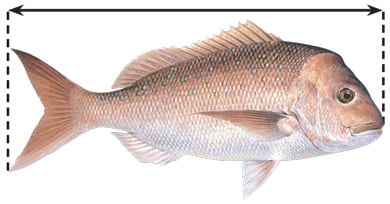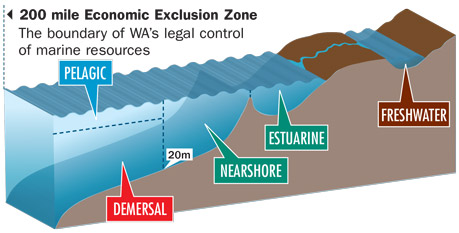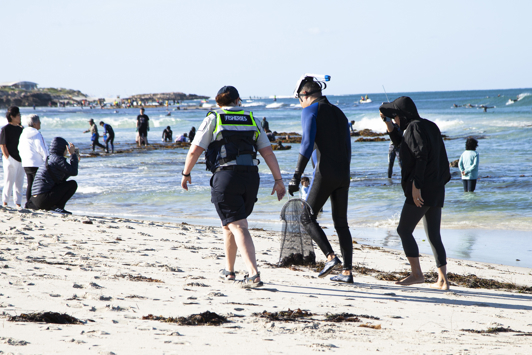A ‘bag limit’ is the maximum number of fish you are legally allowed to take or bring on to land in any 24-hour period (from midnight to midnight, except from midday to midday for marron, prawns, and when recreationally set netting). Daily bag limits can apply to mixed species and individual species.
Mixed species
A ‘mixed species daily bag limit’ is the combined maximum number of fish of any species within one finfish category (such as demersal or large pelagic) that a fisher may take per day.
For example, demersal scalefish in the West Coast bioregion have a total mixed bag limit of 2 fish per day.
|
2 fish = one baldchin groper + one pink snapper |
OR |
2 fish = 2 pink snapper (but no other demersal scalefish) |
Note that within the mixed daily bag limit, you cannot exceed the stated individual species limit (see below). For example, you may only take a maximum of one coral trout per day.
Individual species
An ‘individual species daily bag limit’ is the maximum number of an individual species you may take within your total mixed species daily bag limit (see above).
An individual bag limit is shown in the bag and size limit tables next to a group of species. This number applies to each of the individual species in that group.
For example, emperors (except blue-lined emperor) have an individual daily bag limit of three in all bioregions, except the West Coast bioregion. They are also within a mixed species daily bag limit of five (across all demersal scalefish for these bioregions).
|
5 fish = 3 red-throat emperor (species has an individual species bag limit of 3) and 2 spangled emperor. |
OR |
5 fish = 3 spangled emperor (species has an individual species bag limit of 3) and 2 red-throat emperor. |
A ‘boat limit’ is the maximum number of fish from a species or group of species that may be on a boat or attached to a boat at any one time. This limit applies regardless of how long the vessel is at sea.
On day-trips in powered boats, there must be 2 or more recreational fishing from boat licence (RFBL) holders on board to take a boat limit.
For example, there is a boat limit of 4 demersal scalefish in the West Coast bioregion. Even if three RFBL holders are fishing from a boat for demersal scalefish in the West Coast bioregion, the number of demersal scalefish allowed to be on board cannot exceed 4.
Similarly, if 4 licensed fishers are crabbing from a boat in the West Coast bioregion, they could have a maximum of 20 blue swimmer crabs on board.
Unlicensed fishers can fish if at least one person on board has an RFBL, provided the total catch of everyone on board stays within the bag limit of the one or more licensed boat fishers. It is the master of the boat's responsibility to ensure this rule is followed.
Boat limits apply statewide for blue swimmer crabs, mud crabs, squid, octopus, cuttlefish, greenlip/brownlip abalone, rock lobster and in the West Coast bioregion for demersal scalefish.
Note: This rule only applies to the RFBL and not to other fishing licences.
Size limits indicate the minimum or maximum size that a fish must be to be kept.
To check if your catch is of a legal size, measure finfish from the point of the snout to the tip of the tail.

Free size limit stickers are available from DPIRD offices or participating retail stores.
A finfish ‘possession limit’ is the maximum number of finfish (either whole or in pieces) that a person may have in their control/ownership.
The following general finfish possession limit applies anywhere in WA, except in the specific situations outlined below:
- 10 kg of finfish fillets of any species* with no skin required, plus an additional 10 kg of fillets from large pelagic species such as tuna and shark with skin on
- 10 kg of fish fillets of any species and one day’s bag limit of whole fish or fish trunks
- 2 days’ bag limit of whole fish or fish trunks.
* You may be in possession of 20 kg of fish fillets of any species:
- at your permanent place of residence
- if you have participated in an extended fishing tour involving overnight accommodation on a charter boat, provided the fish are labelled with the person’s full name, the name of the charter boat and the date that the tour ended.
Abrolhos Islands
At the Abrolhos Islands, the finfish possession limit is either:
- 5 kg of fillets from any species, plus 5 kg of fillets from large pelagic finfish (must have skin attached for identification purposes) or
- one day’s bag limit of whole fish.
Note: the West Coast demersal scalefish boat limit applies within the Abrolhos Islands fish habitat protected area. If you fillet your demersal scalefish, the boat possession limit still applies, and two fillets of fish equal 1 whole fish.
Shark Bay Freycinet Estuary management zone
In the Shark Bay Freycinet Estuary management zone, the possession limit is either:
- 5 kg of fish fillets or
- one day’s bag limit of whole fish or fish trunks.
Lalang-garram / Camden Sound Marine Park
The finfish possession limit in the Jungulu Special Purpose Zone is either:
- 1 whole fish or
- two fillets of fish.
Barramundi
The possession limit for barramundi, when not at your principal place of residence, is:
- 2 whole barramundi or
- 4 fillets of barramundi.
Information about filleting your fish
'Fillet' means any particular piece of a finfish other than a whole fish, fish trunk, head, tail, fin, backbone or wing. For those pieces to be excluded from the possession limit they must be entirely removed from the fillet.
'Trunk' means a fish that has had its head and tail removed. Large pelagic species such as mackerel can be cut in 2 pieces and still considered one whole fish or fish trunk.
If you are filleting your finfish catch on day trips, 2 fillets or pieces of fish equals to one whole finfish for the purpose of enforcing bag and boat limits.
When filleting fish at sea, fillets must be left with skin on. Fish with a maximum size limit cannot be filleted at sea and need to be landed whole. All other fish can be carried at sea and landed:
- filleted, skin on
- trunked, skin on
- whole (can be gutted and gilled).
Exceptions to finfish possession limits
The following baitfish are not included in the finfish possession limit:
- hardyhead (Atherinidae)
- sardines/pilchards (Clupeidae)
- whitebait (Engraulidae)
- garfish (Hemirhamphidae)
- mullet (Mugilidae).
Commercially purchased fish are not included in the finish possession limit, but you may be asked to provide proof of purchase as some species have a specific possession limit. Note that recreationally caught fish cannot be transported unaccompanied using a commercial courier.

Fishing rules apply to finfish based on their habitat and biology categorisation. These categories include demersal, pelagic, nearshore, estuarine and freshwater finfish.
Demersal finfish typically live on or near the ocean floor usually at depths of more than 20 metres.
Large pelagic finfish typically inhabit the surface or middle depths of the ocean.
Nearshore and estuarine finfish typically live in the estuary reaches of rivers and/or in the ocean usually in depths of water up to 20 metres.
Freshwater species typically live in the mid to upper non-saline reaches of rivers. They also live in freshwater lakes and dams. Freshwater species are part of a managed fishery.
To fish for freshwater species in the south-west of WA, a south-west licence is required.

